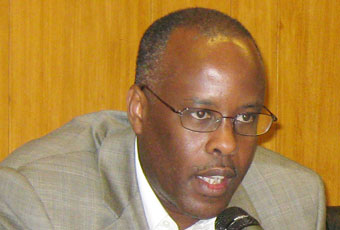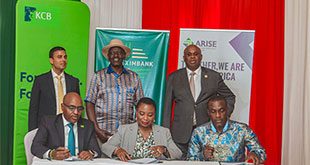
By Patrick Kagenda
Who would want to put their money in a company whose net worth is not clear?
Since the National Insurance Corporation (NIC) issued its long awaited Initial Public Offer (IPO) on December 31, 2009, the event has raised several questions that remain unanswered.
Top on the list is why the Capital Markets Authority, the Privatisation Unit, and the Uganda Securities Exchange, would go ahead with issuing of the NIC IPO amid controversy and accusations of wrong-doing from the Makerere University Dons Association (MUASA) over an unclear sum that is said to be between Shs 13 billion and Shs 16 billion.
The second question is why NIC, whose hope of raising up to Shs 7 billion in new market capitalization from the public, would undertake such a venture when its credibility is being questioned by such a reputable institute as Makerere University.
Efforts to talk to Japheth Kato, the CMA chief executive officer and Jim Mugunga, the spokesperson of the government privatisation unit proved fruitless but Simon Rutega, the CEO of the Uganda securities Exchange, said the IPO went ahead because the disagreement between Makerere and NIC is “normal”.
“It’s normal for people to have disagreements but they will solve the matter,” he said, “The NIC IPO was approved by the regulator; the Capital Markets Authority”.
Officials of MBEA, the stock brokerage firm that is the lead advisor on the NIC IPO also defended the listing.

“The problem about the MUK Shs 16 billion pension fund with NIC is not a big issue. They will sit as learned people and sort it out,” said Musa Nsubuga, the MBEA Sales and Trade Analyst.
Despite Nsubuga’s attempts to reassure potential investors, Makerere’s Shs 16 billion claim from NIC is a big issue. That sum is about a quarter of NIC’s total assets.
At 2008 figures, NIC reported Total Assets worth Shs 75 billion and liabilities worth Shs 63 billion. That left it with Share Capital and Reserves worth Shs 11 billion which is far less than what Makerere is demanding.
That means representatives of Makerere University have a significant stake in NIC.
Representatives of Makerere University staff claim NIC owes them the Shs 16 billion as their pension fund.
In its prospectus, NIC says that by Group Master Policy (GMP) No. DAP/22/30 dated to be effective 1st July, 1996, it undertook to manage the retirement saving scheme known as the Deposit Administration Account for some of Makerere University Kampala (MUK) employees.

It acknowledges, however, that that MUK stopped payment of contributions in 2005 when the Nigerian company, Industrial and General Insurance Company (Plc) acquired a 60% stake in NIC in a government-driven privatization drive.
Until then, NIC had been owned 100 percent by the government of Uganda. At that point Makererere staff was concerned about their pension funds falling into hands of a foreign private firm.
MBEA’s Nsubuga told The Independent that this fear possibly persists among Makerere staff but it’s unfounded.
“Their fear could be that government is pulling out of NIC,” he said, “Governments’ pulling out of NIC is good because the company is going to become a public company where transparency will be a top pre- requisite. Besides, once the company becomes a public company it will become even more profitable.”
The Nigerian company also owns Global Trust Bank Ltd in Uganda, which was licensed by the Bank of Uganda and commenced commercial operation in November 2008.

MUK notified NIC that it had discontinued the scheme and demanded that NIC pays them. However, a dispute arose over the worth of the pension and how it could be paid.
Since then, NIC has insisted that the pension fund remains because Makerere staff have been making claims on the scheme and NIC has been paying all the withdrawal and retirement benefits as at when reported.
NIC says the instrument binding the transaction is the GMP and the Trust Deed & Rules and that to determine the level of MUK funds currently under NIC Management the GMP provides that a valuation of the scheme could be undertaken by an Actuary.
In the prospectus, however, it tactfully avoids naming a figure on the worth of the Makerere pension fund. Instead, it groups it together with the Total Amounts Payable under Deposit Administration Contracts which amount to Shs 34 billion.
The usual practice is that major outstanding issues are highlighted in the section on risk factors.
However, in its prospectus NIC discloses the existence of a contingent liability in respect of a dispute between NIC and the Board of Trustees (BOT) of Makerere University Deposit Administration Plan (DAP) but it adds: “The amounts in dispute have not been disclosed in the Information Memorandum as would be required. However, the amounts in dispute have not been determined by NIC’s actuary.”

In a note to potential investor in the prospectus, CMA warns that the NIC securities have not been approved or disapproved by it.
“Prospective investors should carefully consider matters set forth under the caption “Risk Factors”,” it says.
In that section, NIC says meetings have been held between NIC and Makerere with a view to reconciling the amounts.
“The Directors of NIC are of the opinion that the reconciliation process will not result into a significant liability in excess of the amount already included in the DAP. However, the eventual outcome, and the financial impact, if any, cannot be presently determined until the discussions are concluded and the matter settled.”
The question, therefore, is why after that inconclusive conclusion, NIC issued the IPO? Who would want to put their money in a company whose net worth is not clear?
Part of the answer could be that NIC’s target is foreign rather than local investors.
Usually foreign investor involvement is controlled. In the case of the 2008 IPO by the Kenyan telecom giant Safaricom, they were allowed only 15 percent of the shares on offer,
In the NIC case, however, the prospectus notes that “the GoU foreign investment policy does not limit or restrict any foreign investor from applying for the shares on Offer.”
The government’s stated objective in selling off its 40 percent shareholding in NIC include the need to broaden direct share ownership in Uganda’s most successful companies by enabling the general public, institutional investors, employees, and other interested parties to participate in their equity, promoting Uganda’s capital markets, and enhance investor and general public awareness of share ownership.
If it was not clouded in the Makerere pension fund squabbles, NIC would be an attractive investment.
Since its privatization in 2005 its gross premium income has grown by over 100% from Shs 7 billion in 2005 to Shs 14 billion in 2008. Within the same period, profit after tax grew from Shs 980 million in 2005 to Shs 2.6 billion in 2008. The company has consistently paid dividends since 2005. It rates itself as the fourth largest firm in the country with up to 10% of the market.
The total volume of shares it is selling is 161,522,000 and the offer price per share is Shs 45 while the minimum number of shares one can buy is 2,000. According to the IPO time table, trading of the NIC shares on the Uganda Securities Exchange will commence on March 25.
Stanbic Bank Investment Manager, Patrick Mutimba, says he is confident that the CMA approved the NIC IPO after the company had met all the requirements of the CMA.
“The CMA can’t approve a company with issues as this would taint the regulators standing. CMA have a drive to do things to their best,” he says. He adds, however that: “People investing in the NIC IPO should take account and make independent decisions in terms of the risk.”
 The Independent Uganda: You get the Truth we Pay the Price
The Independent Uganda: You get the Truth we Pay the Price



